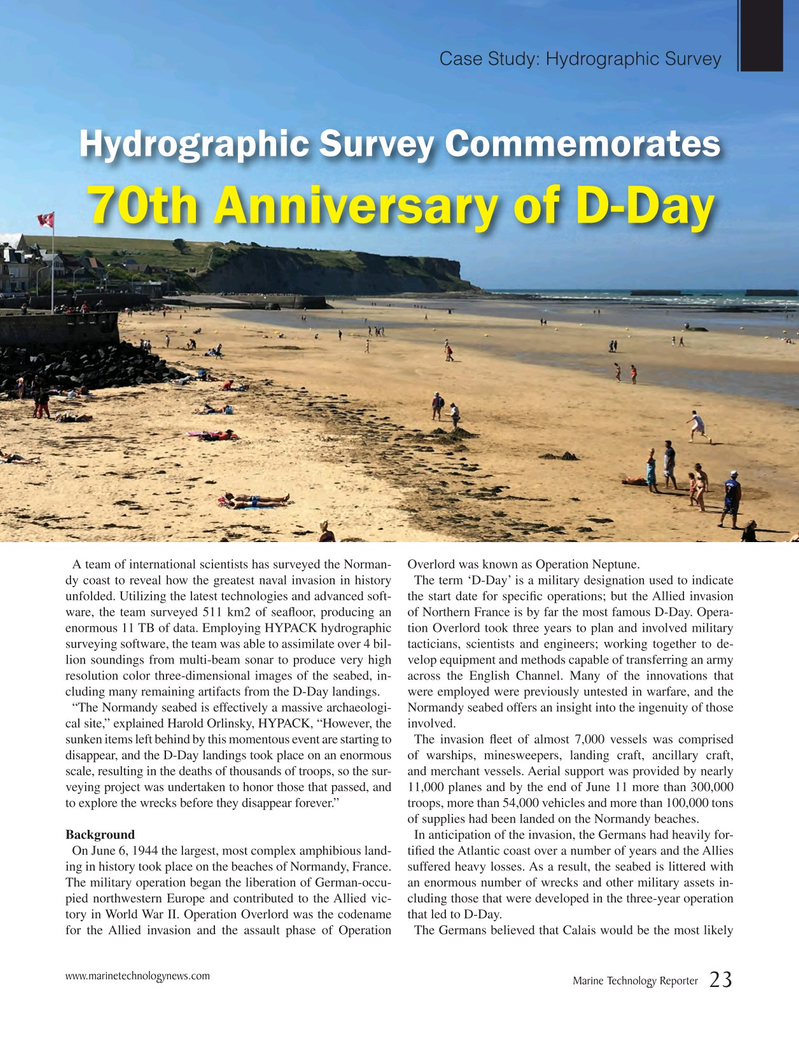
Page 23: of Marine Technology Magazine (November 2016)
Subsea Engineering & Construction
Read this page in Pdf, Flash or Html5 edition of November 2016 Marine Technology Magazine
Case Study: Hydrographic Survey
Hydrographic Survey Commemorates Hydrographic Survey Commemorates 70th Anniversary of D-Day70th Anniversary of D-Day
A team of international scientists has surveyed the Norman- Overlord was known as Operation Neptune.
dy coast to reveal how the greatest naval invasion in history The term ‘D-Day’ is a military designation used to indicate unfolded. Utilizing the latest technologies and advanced soft- the start date for speci? c operations; but the Allied invasion ware, the team surveyed 511 km2 of sea? oor, producing an of Northern France is by far the most famous D-Day. Opera- enormous 11 TB of data. Employing HYPACK hydrographic tion Overlord took three years to plan and involved military surveying software, the team was able to assimilate over 4 bil- tacticians, scientists and engineers; working together to de- lion soundings from multi-beam sonar to produce very high velop equipment and methods capable of transferring an army resolution color three-dimensional images of the seabed, in- across the English Channel. Many of the innovations that cluding many remaining artifacts from the D-Day landings. were employed were previously untested in warfare, and the “The Normandy seabed is effectively a massive archaeologi- Normandy seabed offers an insight into the ingenuity of those cal site,” explained Harold Orlinsky, HYPACK, “However, the involved. sunken items left behind by this momentous event are starting to The invasion ? eet of almost 7,000 vessels was comprised disappear, and the D-Day landings took place on an enormous of warships, minesweepers, landing craft, ancillary craft, scale, resulting in the deaths of thousands of troops, so the sur- and merchant vessels. Aerial support was provided by nearly veying project was undertaken to honor those that passed, and 11,000 planes and by the end of June 11 more than 300,000 to explore the wrecks before they disappear forever.” troops, more than 54,000 vehicles and more than 100,000 tons of supplies had been landed on the Normandy beaches.
Background In anticipation of the invasion, the Germans had heavily for-
On June 6, 1944 the largest, most complex amphibious land- ti? ed the Atlantic coast over a number of years and the Allies ing in history took place on the beaches of Normandy, France. suffered heavy losses. As a result, the seabed is littered with
The military operation began the liberation of German-occu- an enormous number of wrecks and other military assets in- pied northwestern Europe and contributed to the Allied vic- cluding those that were developed in the three-year operation tory in World War II. Operation Overlord was the codename that led to D-Day.
for the Allied invasion and the assault phase of Operation The Germans believed that Calais would be the most likely www.marinetechnologynews.com
Marine Technology Reporter 23
MTR #9 (18-33).indd 23 MTR #9 (18-33).indd 23 12/7/2016 2:53:15 PM12/7/2016 2:53:15 PM

 22
22

 24
24
